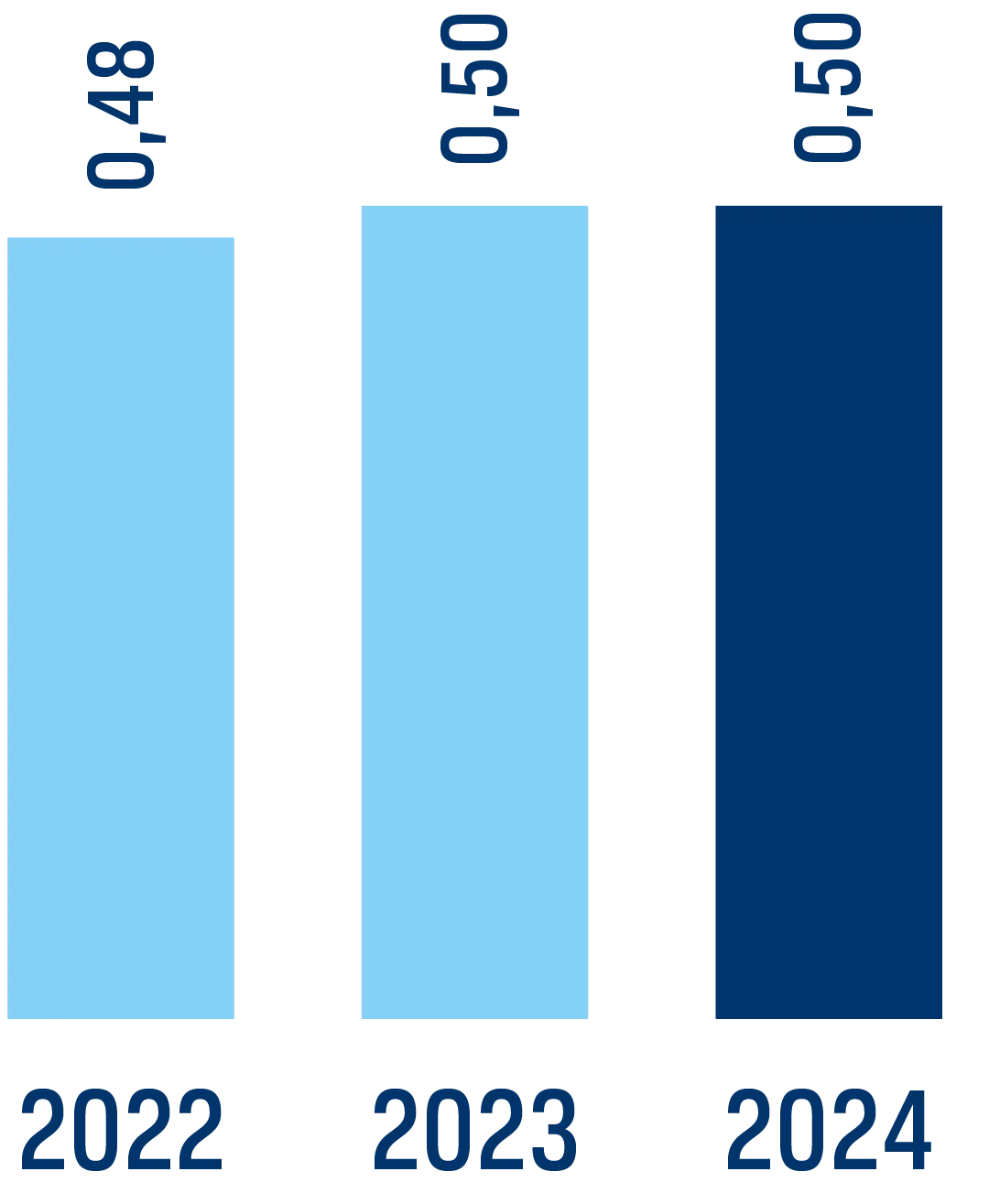Stena Line
Stena Line
Summary of 2024
With 44 vessels, 20 ferry routes and five ports, Stena Line is one of the world’s largest ferry companies. It is an important part of European infrastructure and has around 6,200 employees working in eleven countries. Over 25,000 crossings were made during the year carrying 6.3 million passengers and more than two million transport freight units. www.stenaline.com
The economic situation in Europe in 2024 featured the same challenges as in recent years: great deal of uncertainty, high inflation and rising costs.
The vital freight market continued to show a downward trend. Freight customers are under economic pressure and are looking for cost-effective logistics solutions. More and more freight customers are also leaving trailers in the port and allowing Stena Line to transport their goods without accompanying drivers. This is part of the company’s offering of tailor-made, intermodal logistics solutions, which the company is able to offer together with external partners thanks to good port infrastructure.
During the year, Stena Line continued its digitalisation of the entire customer journey, from booking through to crossing. This has provided better opportunities to understand the customer and adapt the offering. By using AI, the company has been able to streamline both pricing and the utilisation of cargo decks in order to provide customers with the best service. AI is also a support that enables vessels to sail with even greater energy efficiency.
As part of the company’s streamlining work, a cost reduction programme was launched in 2024. It will take full effect in 2026 and is expected to improve EBITDA by SEK 500 million compared with 2024. The programme also involves continuing investment in digitalisation.
At the same time, a continued focus on customer care has resulted in record-high customer satisfaction and greater market shares for Stena Line.
First year of emissions trading
Sustainability goes hand in hand with Stena Line’s core values. Its strategy to reduce emissions involves both investing in more energy-efficient vessels and also optimising systems on board existing vessels to achieve more efficient operations. Stena Line works on several different goals in order to reduce emissions. These involve both efficiency goals and goals for absolute reductions. The industry’s climate and environmental impact is a challenge that needs to be addressed both through individual company and industry initiatives and through predictable global agreements that are competitively neutral.
2024 was the first year that Stena Line was affected by the EU Emissions Trading System (ETS), which aims to reduce the climate impact of business. The challenge in terms of Stena Line’s sustainability work is therefore to balance the cost increases associated with emission allowances and the need for investment in the fleet with a market that has so far been reluctant to pay extra for sustainable solutions. The interplay between these factors is currently limiting the potential speed of the transition.
Foundation laid for sustainable growth
Stena Line has been able to make investments to secure its future and lay the foundation for profitable and sustainable growth.
Building of the Stena Futura and the Stena Connecta began during the year, the company’s first ‘New Max’ hybrid vessels, which will contribute to the green transition of the fleet. These RoRo vessels will be able to run on both electricity and alternative fuels such as biodiesel and methanol. The vessels are expected to be commissioned in 2025 and 2026.
Stena Line is building a brand new RoRo terminal at Immingham in the UK together with Associated British Ports (ABP). The company already has an agreement with ABP to operate the terminal for the next 50 years.
A new route between Dublin and Liverpool was opened in February 2024. During the year 49 per cent of Moroccan ferry company AML was acquired, and Stena Line took over responsibility for and operation of the company’s two ferry routes between Morocco and Spain. This investment will cover the freight volumes that are expected to increase in the region due to industrial growth and Morocco’s growing international trade.
Sustainability performance
Environment
Carbon emissions (CO2 tonnes) per nautical mile

Goal: to reduce carbon emissions by 2.5% per nautical mile per year.*
Comments: A number of actions have been taken to reduce fuel consumption per nautical mile, but as the fleet’s two smallest vessels (which also consume the least amount of fuel) are no longer operated by Stena Line, the combined result remains unchanged compared with the previous year.
*See the Annual Report, page 78, for the absolute emission reduction goal.
Society
SHARE OF ADDRESSED PURCHASE VOLUME THAT HAS SIGNED THE SUPPLIER CODE OF CONDUCT
Equivalent to more than 855 suppliers.
95%
Goal: 95% of addressed procurement volume. Addressed volume is approximately 92% of total purchases.
35%
Share of Total income
6,212
Employees
19,535
Income, MSEK
22,246
Capital employed, MSEK
34
RoPax vessles
10
RoRo vessles
